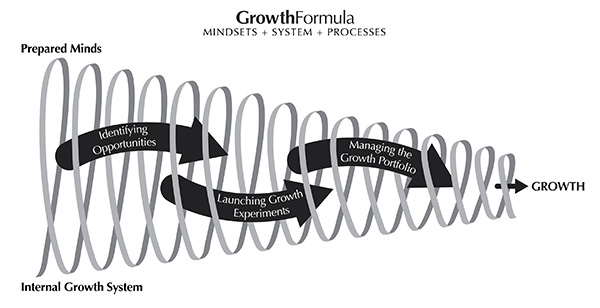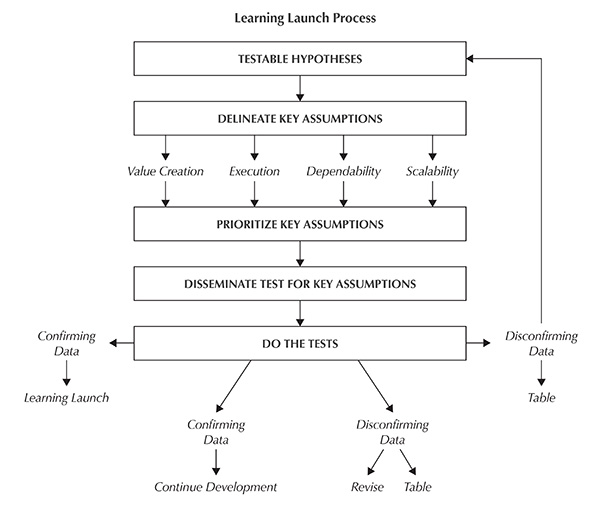

 Article
Article


Almost all businesses today strive to grow. However, consistent business growth is the exception, not the rule.
Organic growth is rife with ambiguity, uncertainty and change, presenting major challenges for business leaders. Until recently, few tools offered a comprehensive road map to help firms navigate the path to consistent growth.
Our body of research has led us to develop a model — a Growth Formula — that captures the essential elements involved in creating a strategic capability for consistent growth.

There are three key aspects of our Growth Formula:
In The Physics of Business Growth: Mindsets, System and Processes, we explore each of these aspects in detail.
Following is an excerpt from the book that explores one of those processes — how to use a technique we call a “Learning Launch” as a fast, low-cost way to evaluate growth opportunities.
Most growth ideas are based on assumptions or educated guesses. Testing them all simultaneously would be time consuming and costly. A key objective of the Learning Launch process is to facilitate rapid and low-cost learning. Because a Learning Launch is an iterative learning process, one can start by testing a new idea’s most critical assumptions — the assumptions that if disconfirmed would require dropping the idea or making major changes to it.
So we are looking for a relatively quick assessment by focusing first on foundational assumptions: For this idea to be viable, what assumptions must be true?
The low-cost feature of this process comes from the studies of successful serial entrepreneurs. Contrary to popular belief, they are not big risk-takers with new ideas. Instead, they place small bets — bets that have acceptable costs or losses if they do not pan out.
The idea is to learn in a relatively low-cost way so you can test many potentially good ideas. Remember, if you generate 1,000 growth ideas and choose 100 of those ideas to test with Learning Launches, you can expect 10 or so to prove worthy of further exploration. You want to learn quickly and cheaply so that you can conduct a large number of Learning Launches from which you will identify a small number of ideas worthy of further development.
The Learning Launch process involves eight steps:
Over the last four years, we have worked with many companies on the design of over 200 Learning Launches. What have we learned?
First, we have learned that the Learning Launch process requires a different way of thinking for most businesspeople, especially those working in product-centric companies. Like anything new, it takes practice to become good at the process.
Second, companies report that experience with the systematic analytical processes involved in evaluating new ideas through Learning Launches can enhance critical thinking more broadly.
Here is a chart of the process:

The data you gather from Learning Launches will enable a management review committee to make the decision to continue exploration, move to development or drop the idea. This decision will be influenced by the organization’s Growth Portfolio. Creating and managing a Growth Portfolio is the final process of the Growth Formula. Together, the elements of that formula — people, system and processes — create a strategic capability for growth.
This post contains an excerpt from The Physics of Business Growth: Mindsets, System, and Processes by Darden Professors Ed Hess and Jeanne Liedtka (Stanford University Press, 2012).
Hess is a top authority on organizational and human high performance. His studies focus on growth, innovation and learning cultures, systems and processes, and servant leadership.
Hess has authored 13 books, including The Physics of Business Growth: Mindsets, System and Processes, co-authored by Darden Professor Jeanne Liedtka; Grow to Greatness: Smart Growth for Entrepreneurial Businesses; Learn or Die: Using Science to Build a Leading-Edge Learning Organization and Humility Is the New Smart: Rethinking Human Excellence in the Smart Machine Age (January 2017), co-authored by Katherine Ludwig. His newest book is Hyper-Learning: How to Adapt at the Speed of Change (September, 2020). He has written more than 160 practitioner articles and 60 Darden cases, and his work has appeared in more than 400 global media publications.
B.S., University of Florida; J.D., University of Virginia; LLM, New York University
Liedtka is an expert on the hot topic of design thinking and how it can be used to fuel innovation and organic growth.
Liedtka’s most recent books are The Catalyst: How You Can Lead Extraordinary Growth (named one of Businessweek’s best innovation and design books of 2009), Designing for Growth: A Design Thinking Tool Kit for Managers (winner of the 1800 CEO READ best management book of 2011), The Physics of Business Growth (2012) and Solving Business Problems With Design: 10 Stories of What Works (2013). Her latest book, Design Thinking for the Greater Good, studies design-led innovation projects in government and social sectors.
B.S., Boston University; MBA, Harvard University; DBA, Boston University